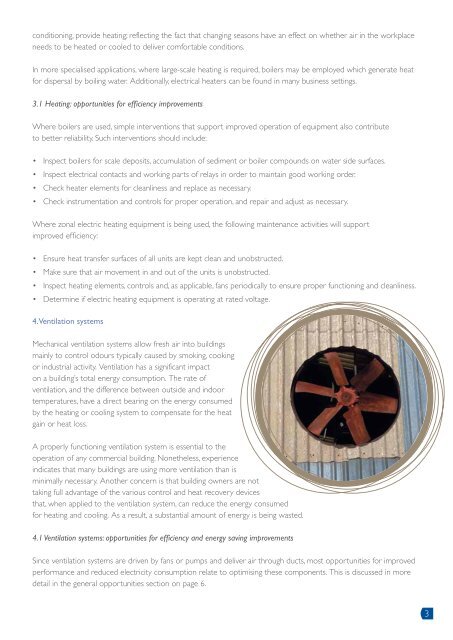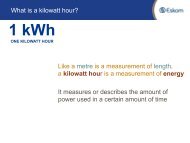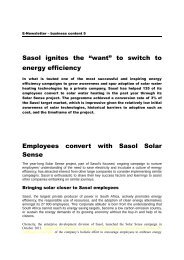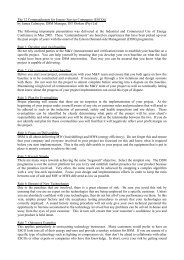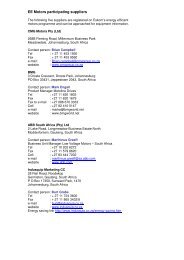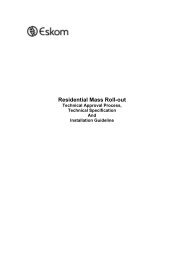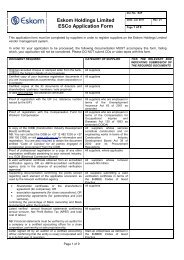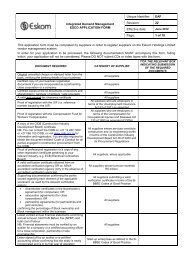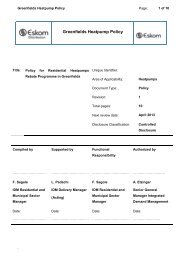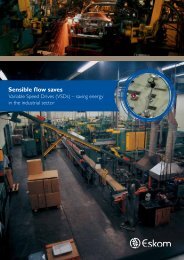HVAC brochure - Eskom IDM
HVAC brochure - Eskom IDM
HVAC brochure - Eskom IDM
Create successful ePaper yourself
Turn your PDF publications into a flip-book with our unique Google optimized e-Paper software.
conditioning, provide heating; reflecting the fact that changing seasons have an effect on whether air in the workplace<br />
needs to be heated or cooled to deliver comfortable conditions.<br />
In more specialised applications, where large-scale heating is required, boilers may be employed which generate heat<br />
for dispersal by boiling water. Additionally, electrical heaters can be found in many business settings.<br />
3.1 Heating: opportunities for efficiency improvements<br />
Where boilers are used, simple interventions that support improved operation of equipment also contribute<br />
to better reliability. Such interventions should include:<br />
• Inspect boilers for scale deposits, accumulation of sediment or boiler compounds on water side surfaces.<br />
• Inspect electrical contacts and working parts of relays in order to maintain good working order.<br />
• Check heater elements for cleanliness and replace as necessary.<br />
• Check instrumentation and controls for proper operation, and repair and adjust as necessary.<br />
Where zonal electric heating equipment is being used, the following maintenance activities will support<br />
improved efficiency:<br />
• Ensure heat transfer surfaces of all units are kept clean and unobstructed.<br />
• Make sure that air movement in and out of the units is unobstructed.<br />
• Inspect heating elements, controls and, as applicable, fans periodically to ensure proper functioning and cleanliness.<br />
• Determine if electric heating equipment is operating at rated voltage.<br />
4. Ventilation systems<br />
Mechanical ventilation systems allow fresh air into buildings<br />
mainly to control odours typically caused by smoking, cooking<br />
or industrial activity. Ventilation has a significant impact<br />
on a building’s total energy consumption. The rate of<br />
ventilation, and the difference between outside and indoor<br />
temperatures, have a direct bearing on the energy consumed<br />
by the heating or cooling system to compensate for the heat<br />
gain or heat loss.<br />
A properly functioning ventilation system is essential to the<br />
operation of any commercial building. Nonetheless, experience<br />
indicates that many buildings are using more ventilation than is<br />
minimally necessary. Another concern is that building owners are not<br />
taking full advantage of the various control and heat recovery devices<br />
that, when applied to the ventilation system, can reduce the energy consumed<br />
for heating and cooling. As a result, a substantial amount of energy is being wasted.<br />
4.1 Ventilation systems: opportunities for efficiency and energy saving improvements<br />
Since ventilation systems are driven by fans or pumps and deliver air through ducts, most opportunities for improved<br />
performance and reduced electricity consumption relate to optimising these components. This is discussed in more<br />
detail in the general opportunities section on page 6.<br />
3<br />
124537ESKD <strong>HVAC</strong> <strong>brochure</strong>.indd 5<br />
2010/09/10 9:53 AM


